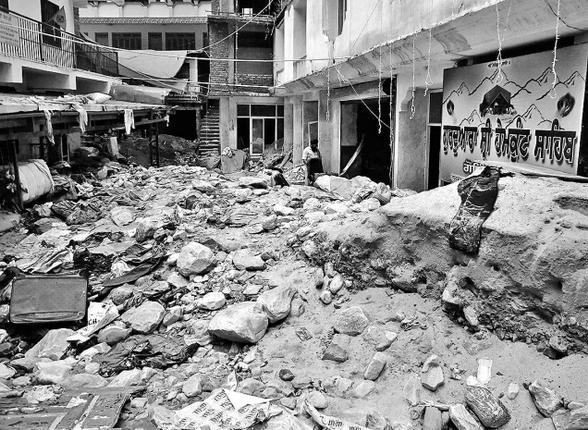Floods Wash Away Livelihood, Uttarakhand Residents Are of Ambivalent Minds

Govindghat, June 27, 2013: “I don’t know,” Devendra Singh kept saying, when asked about any plans to look for alternative means of livelihood.
The once-prosperous trader who owned two stores near the gurdwara here in Uttarakhand’s Chamoli district, has nothing to bank on anymore. The Alaknanda swept it all away.
He said: “I’ve lost everything. I’ve been here for more than 36 years, but now I’ve nothing to stay on for.” The uncertainty is palpable.
Yet, Devendra Singh insisted to us, visitors: “Please have water, have tea. I’ll tell my wife, she’ll prepare food for you.”
He used to earn around Rs. 40 lakh a year from his shops. Now he seemed set to return to his native Amritsar, to start afresh.
His story is no different from that of many others in Govindghat, which was hit by waves of water on June 17. Many residents do not know what alternative sources of livelihood they would be able to look for, being left with no money.
Seva Singh, who was overseeing reconstruction at the gurdwara, said: “We didn’t sleep that night. The Alaknanda rose around 70 feet higher than its normal level on June 17.” It swept away buildings along its banks, including more than 50 shops and parts of the gurdwara. People at the gurdwara were evacuated. Rations worth Rs 2.5 crore got buried in silt, according to Seva Singh.
A barrage that stands some 3 km from Govindghat, was shut on June 16 when water from the Alaknanda flooded it.
Up to three storeys of many buildings remain under silt. Those houses that still stand have developed cracks.
The evacuation of the 9,000 pilgrims who were in the area took three to four days. Many natives of Badrinath, where thousands of pilgrims are still stranded, are also leaving along with pilgrims.
Manoj Kumar, who used to work at Badrinath, asked: “Why would people stay back at Badrinath? Their only means of livelihood, their shops that earned good money during the Char Dham Yatra, are no more. In any case, there will be no pilgrims for at least a few years.”
Govindghat is today choc-a-bloc with medical camps. It has groups of people serving water and hot food, paramilitary forces, people from different States who have come to help residents and stranded pilgrims. Vehicles lie about.
Pilgrims are being aided by Indo-Tibetan Border Police personnel to cross a 5-km stretch that has been temporarily built as the road connecting Joshimath and Govindghat was washed away at two spots. ITBP personnel are present along the route. A rope provides extra support to travellers.
While there are many stories of generosity, some people do complain they were looted when they were in misery. An Armyman said: “Some men were selling biscuit packets for Rs. 200 each in Badrinath, until we chased them away.”
Some sadhus and Nepali nationals returning from the Char Dham areas were found to carry lakhs of rupees and jewellery.
People tended to blame the State administration for having created the disaster but appreciated the Army, the Air Force, and the paramilitary personnel for their rescue operations.
Source: The Hindu, DT. June 27, 2013.







